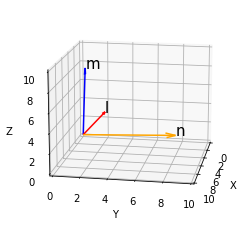1. 공분산
a = np.random.randint(1, 100, size=20) b = np.random.randint(5, 110, size=20) np.cov(a,b) # out # # array([[ 499.16842105, -214.73157895], # [-214.73157895, 924.34473684]])출력 설명
[[Var(a), Cov(a,b)],
[Cov(a,b), Var(b)]]
2. 상관계수
a = np.random.randint(1, 100, size=20) b = np.random.randint(5, 110, size=20) np.corrcoef(a,b) # out # array([[ 1. , -0.31612248], # [-0.31612248, 1. ]])출력 설명
[[corr(a,a), corr(a,b)],
[corr(a,b), corr(a,b)]]
-31% 정도의 음의상관관계가 있다고 볼 수 있다.
3. 계수 구하기
p = [[1, 2, 3],
[2, 3, 1],
[5, 6, 4]]
print("P의 랭크 : {}".format(np.linalg.matrix_rank(p)))
# out
# P의 랭크 : 34. 3D 그래프
from mpl_toolkits.mplot3d import Axes3D l = [1, 2, 3] m = [-1, 0, 7] n = [4, 8, 2] # 3차원 표 그리기 fig = plt.figure() ax = fig.add_subplot(1, 1, 1, projection = '3d') # l 벡터 라인, 텍스트 ax.quiver(0, 0, 0, l[0], l[1], l[2], color ='red', arrow_length_ratio=0.1) ax.text(l[0], l[1], l[2], 'l', size = 15) # m 벡터 라인, 텍스트 ax.quiver(0, 0, 0, m[0], m[1], m[2], color ='blue', arrow_length_ratio=0.1) ax.text(m[0], m[1], m[2], 'm', size = 15) # n 벡터 라인, 텍스트 ax.quiver(0, 0, 0, n[0], n[1], n[2], color ='orange', arrow_length_ratio=0.1) ax.text(n[0], n[1], n[2], 'n', size = 15) # X,Y,Z 크기 설정 ax.set_xlim(0, 10) ax.set_ylim(0, 10) ax.set_zlim(0, 10) # 축 라벨 ax.set_xlabel('X') ax.set_ylabel('Y') ax.set_zlabel('Z') # 볼 각도 설정 ax.view_init(elev=15, azim=10) # 격자 출력 ax.grid() plt.show()out:


